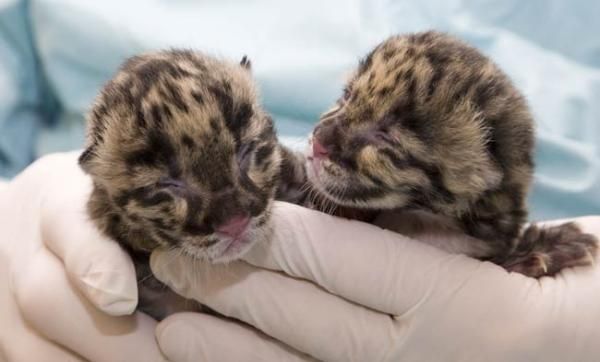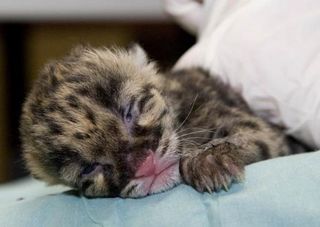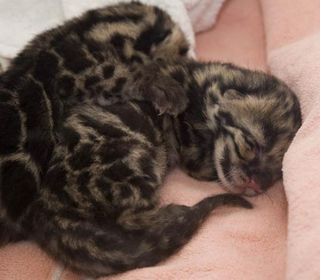
Tiny! Rare Clouded Leopard Cubs Born

A storm of cuteness has descended on the Smithsonian Conservation Biology Institute in Virginia, where two clouded leopard cubs have been born, the center recently announced.
Born to a first-time mother on March 28, the two-week-old clouded leopards, a species native to the forests of Southeast Asia, are healthy and doing well, said Ken Lang, supervisor of SCBI's mammal unit.
The cubs' mother is from the Nashville Zoo, home of a recent clouded leopard baby boom , and the only other North American zoo with an active breeding pair.
The cubs, one male and one female, have more than doubled in weight since birth the male weighed 9.5 ounces (270 grams) at birth, the female weighed 7.75 ounces (220 grams) and zoo staff are hand-rearing the two, a term that can be a bit deceptive, Lang said.
"They're bottle-fed every meal, but we don't sit with them in our laps and play with them," Lang told OurAmazingPlanet. "We're not trying to make them into pets, just trying to make them more adaptable to captivity, so they are more used to people and noises and activity."

There's ample reason for the practice. Clouded leopards have been notoriously difficult to breed in captivity because males attack the females when the time comes to mate.
For reasons unknown, the adult males become aggressive in captivity, and if the animals are introduced as adults, "there's a good chance the males will kill the females because there's a large discrepancy in size," Lang said.
Sign up for the Live Science daily newsletter now
Get the world’s most fascinating discoveries delivered straight to your inbox.
Fully grown males weigh between 44 and 52 pounds (20 to 24 kilograms), about the equivalent of an Alaskan husky dog, and females are only about half that size.
Hand-rearing cubs allows zoos to introduce a male and female at the relatively tender age of six months.
"They're still cubs, so there's a lot less chance of getting hurt, and they're also at an age that we can sit in the cage with them and sort of referee the introduction," Lang said.
The as-yet-unnamed cubs' father was himself born at the SCBI two years ago, and the 2009 birth marked the first time clouded leopards had been born at the center in 16 years.

Clouded leopards, known for their long tails and acrobatic, tree-loving lifestyle, are considered to be a vulnerable species.
Although they are hunted for their unique whorled gray-and-black coats, and because their body parts are used in traditional medicine, the arboreal cats are also suffering because of the destruction of forests across their native habitat, which stretches from Nepal to eastern China, and as far south as Thailand and parts of Malaysia.
Recently, researchers learned that the world's clouded leopards are actually two distinct species yet much about the cats remains mysterious.
Despite their camera-friendly looks, clouded leopards are incredibly shy, Lang said.
"Nobody really knows that much about them," Lang said. "Only six have been radio collared, and the amount of information gathered was fairly limited, so how they behave in the wild is still a big unknown."
- World's Cutest Baby Animals
- In Images: The Wild Cats of Kruger National Park
- Iconic Cats: All 9 Subspecies of Tiger
Reach Andrea Mustain at amustain@techmedianetwork.com. Follow her on Twitter @AndreaMustain.











